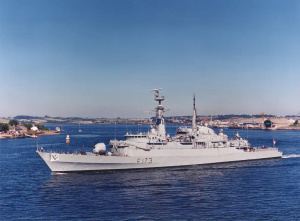Name HMS Arrow Laid down 28 September 1972 Decommissioned 1 March 1994 Construction started 28 September 1972 Length 117 m | Commissioned 28 July 1976 Launched 5 February 1974 Draft 5.94 m | |
 | ||
Hms arrow f173
HMS Arrow was a Type 21 frigate of the Royal Navy. Built by Yarrow Shipbuilders Ltd, Glasgow, Scotland, she was completed with Exocet launchers in 'B' position.
Contents
- Hms arrow f173
- Falklands War service
- Later Royal Navy service
- Pakistan Navy service
- Publications
- References
Falklands War service
Arrow participated in the Falklands War, and had the dual distinction of being both the first British warship to fire on the enemy (whilst firing on land forces at Port Stanley), and the first British warship to be hit by enemy fire, after being strafed by an Argentine Air Force fighter. On 4 May 1982 she assisted in extinguishing the fires and evacuating the crew of the Type 42 destroyer Sheffield, which had been struck by an Exocet missile. The crew showed conspicuous bravery in this rescue effort, saving 225 of the crew of HMS Sheffield, and Arrow's captain, Commander (later Captain) Paul Bootherstone was subsequently awarded the Distinguished Service Cross for gallantry during the action. Arrow also helped extinguish the fires on the Rothesay class frigate Plymouth, on 8 June 1982.
The silhouette of Arrow is to be found, along with the date 1 May, painted on the side of Argentine Air Force Dassault Mirage 5/IAI Finger serial number C-412, along with a similar silhouette representation of HMS Brilliant and the date 21 May, implying a successful action by the aircrew against these vessels. These kill markings are however overstated, and refer merely to damage which both ships suffered during the conflict, which may or may not have been caused by this particular aircraft. Arrow was slightly damaged by cannon fire on 1 May 1982, and HMS Brilliant was slightly damaged by cannon fire on 21 May 1982 outside San Carlos Water. The aircraft was reportedly observed still bearing these distinguishing marks as late as November 2005 (twenty-three years after the conflict) at the multi-national Exercise Ceibo in Argentina.
Arrow also supported troops of the Second Battalion the Parachute Regiment (2 Para) in the successful landing at Goose Green, which eventually led to the recapture of Port Stanley from the enemy.
Later Royal Navy service
By the mid-1980s Arrow was suffering from cracking in her hull. Much of this had first arisen during the Falklands conflict, when engineers were obliged to weld steel plates and girders to parts of the ship where cracks were opening up in the aluminium superstructure. After the war she was taken in for refitting, with a large steel plate being welded down each side of the ship. At the same time modifications were made to reduce hull noise. The vessel continued in service until 1994, and was decommissioned and removed from the fleet on 1 March that year.
Pakistan Navy service
Following decommissioning Arrow was transferred to Pakistan and renamed PNS Khaibar. The Exocet missile system was not transferred to Pakistan and Khaibar had her obsolete Sea Cat missile launcher removed. A quadruple Harpoon missile launcher was fitted in place of the Exocet launchers and a Phalanx CIWS was fitted in place of the Sea Cat launcher. SRBOC chaff launchers and 20 mm and 30 mm guns were fitted. Khaibar remains in service with the Pakistan Navy, who purchased from the United Kingdom Government all six surviving Type 21 frigates of the eight originally built (two were lost in the Falklands).
